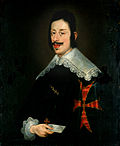You can help expand this article with text translated from the corresponding article in Italian. (September 2025)Click [show] for important translation instructions.
|
This article has multiple issues. Please help improve it or discuss these issues on the talk page . (Learn how and when to remove these messages) |
The Grand Prince of Tuscany was the heir to the Tuscan throne.[ citation needed ]






